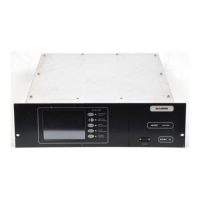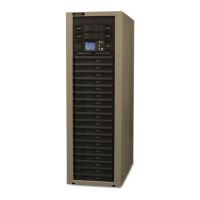______________________________________________HARRIS
888-9058-001
WARNING: Disconnect and lockout AC primary power prior to servicing
197
Now that the correct bias current is known and the quarter module with failed FET(s)
has been located, one can locate the failed FET. Move the current meter to the quarter
module showing abnormally low current. Again, apply DC power only and enable the
module. While observing idle current, slowly rotate the bias control for each transistor
counterclockwise, one at a time; this should reduce the current for the corresponding
FET.
If the idle current does not drop when the pot is turned fully counterclockwise, then the
RF FET is probably bad. To determine which pot affects the idle current of each FET,
refer to Figure A-6. Note the location difference between high band and low band
quarter modules.
Procedure for setting bias current on a quarter module:
First, determine the correct bias current per FET. Connect a current meter in series with
the 50 Volts to the quarter module. Next, set the bias pots fully counterclockwise, apply
50 Volts, and enable the module. The current meter connected to the quarter module
being adjusted should read almost zero current (less than 20 mA). Slowly turn each bias
pot clockwise to set the current for the corresponding FET, then adjust the next bias pot
until a total of twice the current per FET is reached, and so on, until the last FET is
adjusted such that the total current is four times the current per FET.
Example: On a low band class AB stage, after determining that the correct bias for a
given quarter module is 400 mA per FET, start with all bias pots fully counterclockwise.
Slowly turn R25 clockwise until 400 mA is reached, then turn R26 clockwise until 800
mA is reached, then R27 until 1.2 A is reached, and finally turn R28, stopping at 1.6 A
total.
CAUTION:
ADJUSTING THE BIAS POTS TOO FAR CLOCKWISE OR TOO QUICKLY CAN
DESTROY AN RF FET DUE TO EXCESSIVE CURRENT. GO SLOWLY.
8.4 Parts Replacement Procedures
8.4.1 Soldering Precautions
Please read the following precautions before attempting any repair activity:
a. Be sure to use the correct type of solder depending on the repair being made.
For soldering coaxial cables, use a SN 96, AG 4 alloy for lowest loss and best
mechanical strength. For all other joints, use SN 63, PB 37 for its low melting
point.
